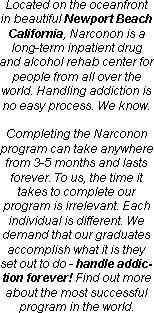
|
Navigate |
| Home |
| Kirstie Alley |
| Our 30th Anniversary |
| Never Turning Back |
| Narconon Endorsements |
| |
|
|
| |
|
|
| |
|
Facts About Drugs |
| FAQ About Ambien |
| FAQ About Ativan |
| FAQ About Cocaine |
| FAQ About Codeine |
| FAQ About Crack |
| FAQ About Darvocet |
| FAQ About Dexedrine |
| FAQ About Demerol |
| FAQ About Dilaudid |
| FAQ About Ecstasy |
| FAQ About GHB |
| FAQ About Heroin |
| FAQ About Hydrocodone |
| FAQ About Ketamine |
| FAQ About Lortab |
| FAQ About LSD |
| FAQ About Marijuana |
| FAQ About Morphine |
| FAQ About Meth |
| FAQ About Methadone |
| FAQ About Opiates |
| FAQ About Opium |
| FAQ About Oxycontin |
| FAQ About Percocet |
| FAQ About Percodan |
| FAQ About Ritalin |
| FAQ About Rohypnol |
| FAQ About Ultram |
| FAQ About Valium |
| FAQ About Vicodin |
| FAQ About Xanax |
  |
|
Resources |

|


 Print this article |  Send this article to a friend |  Add to Favorites |
Scientific Research
A
Review of Scientific Literature Supporting the Detoxification Method
("Purification
Program")
Developed by L. Ron Hubbard. Compiled August, 1991 by the Foundation for Advancements in Science and Education.
Table of Contents
I. Contamination with Synthetic Chemicals
II. Reduction of Bio-accumulated Compounds
III. The Detoxification Program Developed by L. Ron Hubbard
A.
Exercise
B. Sauna
C. Supplements
Niacin
Polyunsaturated Oils
Vitamin Supplementation
D.
Sufficient liquids to offset the loss of body fluids through sweating
E.
Regular diet supplemented with plenty of fresh vegetables
F. A properly ordered
personal schedule which provides the person with the normally required amount
of sleep
IV. Studies Regarding the Detoxification Program
A.
Safety of the Program
B. Results of Detoxification
V. Summary
References
I. Contamination with Synthetic Chemicals
Human exposure to toxic chemicals has dramatically increased in the last century. Millions of compounds have been formulated and some 50,000 are now in commercial use. The environmental persistence of many of these compounds is cause for concern, In addition, many of these synthetic compounds accumulate in biological organisms ("bioaccumulation"), storing in bone, fat, or another compartment of the body.
Hundreds of these compounds are found in U.S. citizens, with many present in each of us (1). In addition to commercial compounds, many drugs -- both pharmaceutical and so-called recreational -- can remain in the body for an extended time. Drugs such as LSD (2, 3), PCP (4), cocaine (5), marijuana (6) and diazepam (7) are found in fat. These drugs can be retained for extended periods, especially under conditions of chronic use (5,8-11).
Adverse health effects have been shown for some of these compounds. Health effects from most compounds have not, however, been studied in detail. Further, the health effects from combinations of chemicals are unknown. It is clearly preferable to have low levels of foreign compounds rather than high.
II. Reduction of Bioaccumulated Compounds
While we still do not fully understand the bio-active mechanisms or the kinetics of many toxic substances, physicians have known for centuries that health problems can ensue as a result of accumulations of xenobiotics (foreign chemicals) and have looked for ways to safely and effectively reduce body burdens.
Ramazzini, in his 1713 work, Diseases of Workers, notes that writers of works on poisons at that time "advise, in general, remedies that have the power of setting the spirits and blood mass in motion and of provoking sweat" (12), a recommendation which aligns well with current knowledge of the kinetics and metabolism of foreign compounds.
Approaches to handling bioaccumulation of harmful chemicals depend on increasing the rate of removal of these compounds. This is accomplished by either altering the compound to a non-toxic form or by enhancing the rate of elimination.
This philosophy has been applied in many ways. In acute poisoning, purging is a key means of removing the toxic compound before adverse effects arise. For this reason, a strong purgative is included in the highly toxic pesticide, paraquat.
Ingestion of compounds known to bind to the contaminating compound has been used in some cases. This increases the rate of removal of the toxic compound because it cannot be reabsorbed as it passes through the intestine. In this manner, cholestyramine was successfully used to reduce levels of Kepone (13), and Prussian blue was used to reduce levels of radioactive Cesium (14).
A fasting technique has been used to enhance the mobilization of fat-stored compounds. This approach resulted in improved symptoms in 16 PCB-exposed Taiwanese patients (15), although the levels of PCBs in the blood of these patients increased.
Ethylenediaminetetraacetate (EDTA) has been used for many years in the treatment of lead toxicity. EDTA binds to lead and other compounds in the blood, the resultant complex then being eliminated. (16,17)
Reduction of fat-stored chemicals must be aimed at mobilizing chemicals from fat stores, distributing the mobilized chemical to routes of elimination, and increasing the rate at which these routes are utilized. This is the design behind the detoxification procedure developed by Hubbard.
III. The Detoxification Program Developed by L. Ron Hubbard
This program was designed to mobilize and enhance the elimination of fat-stored xenobiotics. The Hubbard program was specifically developed to reduce levels of drug residues but has proven to be applicable to the reduction of other fat-stored compounds.
The program has gained widespread support due to its effectiveness and the fact that it is well supported by the medical literature. Each component of the program is in alignment with current research on the mobilization of fat stores and the facilitation of toxin elimination. The components of this program are:
A. Exercise:
Fat is stored throughout the body, with significant deposits not only in adipose tissue but in cellular reserves, membranes, etc. Exercise is aimed at both promoting deep circulation in the tissues and enhancing the turnover of fats.
Numerous studies have shown that exercise promotes the circulation of blood to tissues (18) and also promotes mobilization of lipid from storage depots
(19-24). Mobilization of fat stores is accompanied by mobilization of the toxins stored in the fatty tissue (25-27).
B. Sauna:
Mobilization of chemicals is not desirable if routes of elimination are not enhanced. Chemicals are excreted through many routes including feces, urine, sweat, sebum, and lung vapor.
The purposes of the sauna aspect of this program are two-fold. Heat stress is a means of increasing circulation (28) and of enhancing the elimination of compounds through both sweat and sebum. It is documented that methadone (29), amphetamines (30), methamphetamines and morphine (31), copper (32), mercury (33), additional metals (34) and other compounds appear in human sweat. Enhancement of this elimination route is a key purpose of the sauna aspect of this program.
In addition to an increase in sweat production, increased body temperature results in heightened production of sebum, the material produced by the skin's sebaceous glands (35). In patients exhibiting "chloracne", a specific skin disorder caused by chemical exposure, the causative compounds may be detected both in adipose tissue and in sebum of the skin (36).
Though not a major route of elimination for polychlorinated biphenyls (PCBs), PCBs may be found in sebum of exposed individuals (37). Both the concentration of PCBs and the quantity of sebum produced have been shown to increase during the detoxification program developed by Hubbard (38).
C. Supplements:
Niacin
Effects of specific vitamins are utilized as well. Niacin has a long-term effect of reducing the mobilization of fatty acids (39). However, the initial reduction in mobilized fatty acids following a single dose is followed by a transitory increase in free fatty acid mobilization (40,41).
Mobilization of free fatty acids by other mechanisms has been shown to result in concurrent mobilization of the fat-stored chemicals (26,27). This also appears to occur during this detoxification program. The increased turnover of fat results in mobilization of fat-stored chemicals and the opportunity to eliminate them from the body.
Polyunsaturated Oils
One means of excretion of chemicals is through the bile. However, such bile excretion results in elevated levels of chemicals in the intestine, providing an opportunity for reabsorption of these compounds (42,43).
It has been known for many years that addition of unsaturated oils to the diet can increase the excretion rate of certain compounds. This is due either to blocking the reabsorption of the chemical or to altering the rate at which the compound is excreted (45).
Supplementation with unsaturated fats also affects the content of the stored adipose tissue (45). Apparently, as the stored fats are mobilized and re-stored, the dietary supplements replace some of the mobilized fats so that an exchange is effected.
Vitamin Supplementation
Vitamin and mineral supplementation is included for several reasons. Replacement of vitamins and minerals lost through sweating is one reason. Correction of any deficiencies is necessary as well.
Extensive sweating is a component of this program. As significant levels of vitamins and minerals appear in sweat, their loss through sweating could create deficiencies were they not replaced.
Deficiencies may already be present. Specific vitamin, mineral and amino acid deficiencies are known consequences of alcohol and drug abuse, due either to poor nutrition or to the action of the drugs themselves (46-48). PCB poisoning in animals has been shown to result in a significant decrease of vitamin A in the liver and serum (49,50).
Further, research in animals has demonstrated that vitamin deficiencies retard the metabolism of drugs (51). Changes in nutrient levels, with consequent adverse effects on metabolism, may occur with other chemicals as well.
Supplementation with vitamins is anticipated to assist the individual in several ways. Such supplementation will certainly assist in correction of nutritional deficiencies. It might also be expected to aid in the metabolism of chemicals.
D. Sufficient liquids to offset the loss of body fluids through sweating:
This is a logical necessity during any extended period of sweating. In addition to liquid supplementation, sodium, potassium, calcium-magnesium solution and cell salts are taken on an individual basis. Patients undergoing this detoxification program are monitored to ensure signs of heat exhaustion or salt depletion do not appear.
E. Regular diet supplemented with plenty of fresh vegetables:
This program is not a dietary program. The only change in diet required by patients on this program is that they eat plenty of fresh vegetables. This ensures that bowel movements remain regular.
F. A properly ordered personal schedule which provides the person with the normally required amount of sleep:
The detoxification program is intensive. The mobilization and elimination of stored chemicals can put a stress on the individual's body. Therefore, it is imperative that individuals ensure that they are well-rested during the program.
IV. Studies Regarding the Detoxification Program Developed by L. Ron Hubbard
A. Safety of the Program
An initial study of 103 individuals demonstrated the safety of this program. Medical complications associated with the program occurred in less than 3% of the individuals and were minor in nature. There was one case of pneumonia, one of ear infection, and one case of diarrhea during the approximately 3 weeks of program delivery. Reductions in blood pressure and cholesterol were benefits of the program. The program also resulted in improvements in psychological test scores. (52)
This program is designed to mobilize and eliminate fat-stored chemicals. During any such program in which xenobiotics are deliberately mobilized from fat stores, it is important that elimination keep pace with this mobilization process. Otherwise it is possible that mobilization will result in heightened blood concentrations of the mobilized compounds.
Blood levels of chemicals were monitored in a study of electrical workers conducted by Schnare & Robinson (53). They showed that blood levels of both PCBs and pesticides were fairly consistent over the course of treatment. Thus, elimination of compounds appeared to keep pace with their mobilization during this study.
B. Results of Detoxification
The detoxification method developed by Hubbard has been shown to reduce levels of several fat-stored chemicals. Studies of this method have focused on individuals who have accumulated fat-soluble compounds through either occupational or environmental exposure.
In 1983, Roehm reported reductions in DDE and PCBs and clearing of symptoms in a Vietnam vet with a range of symptoms (54).
A 1984 study demonstrated statistically significant reductions of from 10.1 to 65.9 percent for sixteen fat-stored compounds. The compounds tested included polychlorinated biphenyls (PCBs), polybrominated biphenyls (PBBs) and chlorinated pesticides. The study population had been specifically exposed to PBBs approximately 10 years prior to treatment. Reductions in
PBBs were 58.7 percent (p<0.O5) when treated with the Hubbard method. (55) According to independent evaluation, the chemical levels for PBBs had not reduced during the five years prior to treatment (56).
In a controlled study, electrical workers exposed to hexachlorobenzene (HCB), PCBs and other compounds, were treated with the Hubbard method. Statistically significant reductions of 30% for HCB and 16% for PCBs were observed. These reductions were stable at follow-up observations 3 months subsequent to treatment (53).
Further documentation of PCB reduction was reported in the case of a female factory worker from Yugoslavia. Her excessive PCB levels (102 mg/Kg in adipose and 512 ug/L in serum approximately 50 times higher than the general population) were reduced by 63% in adipose and 49% in serum following treatment. In addition, a spontaneous breast discharge containing PCBs ceased during treatment. This woman's symptoms also improved over the course of treatment. (38)
Improvements in this woman led to a controlled study of a group of male co-workers. Again, reductions in PCB levels were observed and improvements in symptoms noted for the group treated with the Hubbard method. (57,58)
As the number of toxic chemicals in the workplace increases, it is sometimes difficult to identify the exact nature of a toxicant. Such was the case for a woman exposed to both the residues trapped in filters from the exhaust stacks of an oil-fired electrical generator and the contaminated water used to clean these filters. She became ill following 6 months of such exposure and was unable to work. During treatment with the Hubbard method a black substance began oozing from her pores. This abated late in treatment. Both her objective and subjective complaints were reduced following treatment and she was able to return to work. (59)
Firefighters are often exposed to toxic compounds in the course of their work. Such was the case for a group of firefighters responding to a fire involving transformers filled with PCBs. Several of these men became ill following the fire.
Neurophysiological and neuro-psychological tests were conducted on 14 of these firefighters 6 months after the fire. This battery of 22 tests demonstrated that the firefighters who had been involved with the fire were significantly impaired in both memory and cognitive functions when compared to coworkers from the same department who had not participated in fighting this fire. (Scores for 13 of the 22 tests were significantly worse in the exposed firefighters.)
Following treatment with the detoxification method developed by Hubbard, significant improvements in 6 of the 13 tests originally showing impairment were noted. (60)
These firefighters were also tested for peripheral nerve damage. Five of the seventeen firefighters tested showed significant peripheral neuropathy. All showed improvement following treatment with the Hubbard method, with two of the five returning to normal range. (61)
Many people have experienced adverse health effects after exposure to compounds whose identity is unknown. The detoxification program has been shown effective in alleviating symptoms in such patients. In one study, the selected patient population reported symptom profiles prior to treatment that were in alignment with chemically exposed individuals reported by other authors (not statistically different). Following treatment, their symptom profiles had improved significantly and were now not significantly different from a healthy population. (62)
V. Summary
This body of peer-reviewed literature substantiates the effectiveness of the Hubbard program in reducing levels of foreign compounds stored in fat and in improving the symptom profiles of chemically exposed individuals. Health benefits of this program are not limited to symptomatic improvements. In the case of documented impairments in neurological function, these impairments were shown by two independent approaches to be significantly improved by detoxification treatment.
This program has proven to be a safe and effective addition to clinical practice. As the quantity and variety of chemicals employed in our society increase, it can be expected that this program will become increasingly relevant.
REFERENCES
1. Stanley JS (1986) Broad Scan Analysis of Human Adipose Tissue; Volume 1:
Executive Summary EPA 560/5-86-035.
2. Axelrod J, Brady RO, Witkop B and Evarts EV (1957) The distribution and metabolism of lysergic acid diethylamide. Ann NY Acad Sci 66:435-444.
3. Stolman A (1974) The absorption, distribution, and excretion of drugs and poisons and their metabolites. ln:.Progress in Chem Tox, Vol. 5, A Stolman, ed., Academic Press, pp 1-99.
4. James SH and Schnoll SH (1976) Phencyclidine: Tissue distribution in the rat. Clin Tox 9:573-582.
5. Nayak PK, Misra AL and Mule SJ (1976) Physiological disposition and biotransformation of [3H]cocaine in acutely and chronically treated rats. J Pharmacol & Expert Ther 196:556-569.
6. Rodger L Foltz, Ph.D., Personal communication.
7. Friedman H, Ochs HR. Greenblatt DJ and Shader RI (1985) Tissue distribution of diazepam and its metabolite desmethyldiazepam: A human autopsy study. J Clin Pharmacol 25:613-615.
8. Dackis CA, Pottash ALC, Annitto W and Gold MS (1982) Persistence of urinary marijuana levels after supervised abstinence. Am J Psychiatry.139:1196-1198.
9. Martin BR (1982) Long-term disposition of phencyclidine In mice. Drug Metabolism and Disposition 10:189-193.
10. Weiss RD (1988) Protracted elimination of cocaine metabolites In long-term, high-dose cocaine abusers. Amer J Med 85:879-880.
11 Cone EJ and Weddington Jr. WW (1989) Prolonged occurrence of cocaine in human saliva and urine after chronic use. J Analytical Toxicol 13:65-68.
12. Ramazzini, B (1713) Diseases of Workers, New York Academy of Medicine, History of Medicine Series, Vol. 23, Hafner Publishing Co., New York, 1964.
13. Guzelian PS (1982) Chlordecone poisoning: A case study in approaches of detoxification of humans exposed to environmental chemicals. Drug Metab Reviews
13:663-679.
14. Ricks A et al. (1989) The Radiological Accident In Golania, Unipub Publications, Lanham, MD. (Reported by Hixson JR in Medical Tribune, Thursday, September 22, 1988)
15. Imamura M, Tung T-C (1984) A trial of fasting cure for PCB poisoned patients in Taiwan. Am J Ind Med 5:147-153.
16. Chisolm Jr. JJ (1968) The use of chelating agents in the treatment of acute and chronic lead intoxication In childhood. J Pediatrics 73:1-38.
17. Wedeen RP, Batuman V and Landy E (1983) The safety of the EDTA lead-mobilization test. Env Research 30:58-62.
18. Bulow J (1983) Adipose tissue blood flow during exercise. Danish Medical Bulletin 30(2) :85-100.
19. Frledberg SJ, Harlan Jr. WR, Trout DL. Estes Jr. EH (1960) The effect of exercise on the concentration and turnover of plasma nonesterified fatty acids. J Clin Invest 39:215.
20. Carlson LA and Pernow B (1961) Studies on blood lipids during exercise. J Lab and Clin Med 58:673-681.
21. Friedberg SJ, Sher PB, Bogdonoff MD and Estes Jr. EH (1963) The dynamics of plasma free fatty acid metabolism during exercise. J Lipid Research 4:34-38.
22. Horstman D, Mendez J, Buskirk ER, Boileau R and Nicholas WS (1971) Lipid metabolism during heavy and moderate exercise. Med and Sci in Sports .3:18-23.
23. Taylor AW, Shoemann OW, Lovlin R and Lee S (1971) Plasma free fatty acid mobilizatlon with graded exercise. J Sports Med 11:234-240.
24. Wirth A. Schlierf G and Schetler G (1979) Physical activity and lipid metabolism. Klin Wochenshri 57:1195.
25. Findlay GM and de Freitas ASW (1971) DDT movement from adipocyte to muscle cell during lipid utilization. Nature 229:63.
26. de Freitas AS and Norstrom RJ (1974) Turnover and metabolism of polychlorinated biphenyls in relation to their chemical structure and the movement of lipids In the pigeon. Can J Physiol Pharmacal 52:1081-1094.
27. Mitjavila 5, Carrera G and Fernandez Y (1981) Il. Evaluation of the toxic risk of accumulated DOT in the rat: During fat mobilization. Arch Environ Contam Toxicol 10:471-481.
28. Seba DB (1990) Thermal chamber depuration: A perspective on man in the sauna. Clinical Ecology 7:1 -12.
29. Henderson OL and Wilson BK (1973) Excretion of methadone and metabolites in human sweat. Res Comm Chem Path & Pharmac 5:1-8.
30. Vree TB, Muskens ATJM, and Van Possum JM (1972) Excretion of amphetamines in human sweat. Arch Int Pharmacodyn 199:311-317.
31. Ishlyama I, Nagai T, Nagal T, Komuro E, Momose T and Akimori N (1979) The significance of drug analysis of sweat in respect to rapid screening for drug abuse. Z Rechtsmed 82:251-256.
32. Sunderman Jr. FW, Hohnadel DC, Evenson MA, Wannamaker BB and DahI DS (1974) Excretion of copper in sweat of patients with Wilson's disease during sauna bathing. Ann Clinic Lab Sci4:407.
33. Stopford W (1979) Industrial exposure to mercury. In: The biogeochemistry of mercury in the environment, Elsevier/North-Holland Biomedical Press, pp 367-397.
34. Hohnadel DC, Sunderman FW, Nechay MW and McNeely MD (1973) Atomic absorption spectrometry of nickel, copper, zinc, and lead in sweat collected from healthy subjects during sauna bathing. Clinical Chemistry 19:1288-1292.
35. Abe T, Mayuzumi J, Kikuchi, Arai S (1980) Seasonal variations In skin temperature, skin pH, evaporative water loss and skin surface lipid values on human skin. Chem Pharm Bull 28:387-392.
36. Kimbrough RD (1974) The toxicity of polychlorinated polycyclic compounds and related chemicals. CRC Critical Rev Toxicol 2:445-499.
37. Kimbrough RD (1980) Occupational exposure. In: Halogenated biphenvls. terphenyls, naphthalenes. dibenzodioxins and related products, Kimbrough RD, ed., Elsevier/North-Holland Biomedical Press, Amsterdam, pp 373-399.
38. Tretjak Z, Shields M and Beckmann SL (1990) PCB reduction and clinical improvement by detoxification: An unexploited approach? Human and Experimental Toxicology 9:235-244.
39. Carlson LA (1970) Nicotinic acid: its metabolism and its effects on plasma free fatty acids. In: Metabolic Effects of Nicotinic Acid and Its Derivatives, Gey KF and Carl-son LA, eds., Hans Huber, Switzerland, pp 157-165.
40. Carlson LA, Oro L and Ostman J (1968) Effect of a single dose of nicotinic acid on plasma lipids In patients with hyperlipoproteinemia. Acta med scand 183:457-465.
41. Nye ER and Buchanon B (1969) Short-term effect of nicotinic acid on plasma level and turnover of free fatty acids in sheep and man. J Lipid Research 10:193-196.
42. Smith RL (1973) Implications of Biliary Excretion (Chapter 8), In: The Excretory Function of Bile, Chapman and Hail, Ltd., London.
43. Parker RJ, Hirom PC and Miliburn P (1980) Enterohepatlc recycling of phenolphthalein,, morphine, lysergic acid diethylamide (LSD) and diphenylacetic acid In the rat. Hydrolysis of glucuronic acid conjugates in the gut lumen. Xenobiotica 10:689-703.
44. Moore RB, Anderson JT, Taylor HL, Keys A and Frantz ID (1968) Effect of dietary fat on the fecal excretion of cholesterol and its degradation products in man. J Clinical investigation 47:1517-1534.
45. Shepherd J, Stewart JM, Clark JG and Carr K (1980) Sequential changes In plasma lipoproteins and body fat composition during polyunsaturated fat feeding in man. Br J Nutr 44:265-271.
46. Bonjour JP (1980) Vitamins and Alcoholism. InternatJ Vit Nutr Res 50:215-230;307-
338; 51:166-177.
47. Russell AM (1980) Vitamin A and zinc metabolism in alcoholism. Am J Clin Nut
33:2741-2749.
48. Roe, DA (1984) Nutrient and drug interactions Nutrition RevIews 42:141 -1 54.
49. Innami S, Nakamura A, Miyazaki M, Nagayarna S and Nishide E (1977) Further studies on the reduction of vitamin A content in the livers of rats given polychlorinated biphenyls. J Nutr Sci Vitaminol 22:409-418
50 Kato N, Kato M, Kirnura T and Yoshida A (1978) Effect of dietary addition of PCB, DDT or HGT and dietary protein on vitamin A and cholesterol metabolism. Nutr Rep Int 18:437-445.
51. BrIn M and Roe 0 (1979) Drug-diet Interactions. J FIorida M A 66:424-428.
52. Schnare DW, Denk G, Shields M and Brunton S (1982) Evaluation of a detoxification regimen for fat stored xenobiotics. Med Hyp 9:265-282.
53. Schnare DW and Robinson PC (1986) Reduction of human body burdens of hexachlorobenzene and polychlorinated biphenyls. in Hexachlorobenzene: Proceedings of an International Symposium, CR Morris and JRP Cabral, eds., International Agency for Research on Cancer, Lyon, France, pp 597-603.
54. Roehm D (1983) Effects of a program of sauna baths and megavitamins on adipose DDE and POBs and on clearing of symptoms of Agent Orange (dioxin) toxicity. Clin Res 31(2):243a.
55. Schnare DW, Ben M and Shields MG (1984) Body burden reductions of PCBs, PBBs and chlorinated pesticides In human subjects. Ambio. 13:378-380.
56. Wolff MS, Anderson HA and Selikoff IJ (1982) Human tissue burdens of halogenated aromatic chemicals in Michigan. JAMA 247:2112-2116.
57, Tretjak Z. Beckmann S, Tretjak A and Gunnerson C (1989) Occupational, environmental, and public health in Semic: A case study of polychlorinated biphenyl (PCB) pollution. In Post-Audits of Environmental Programs & Projects, C Gunnerson, ed., ASCE, New York, NY, pp 57-72.
58. Tretjak 7, Root DE, Tretjak A, Slivnik R, Edmorndson E, Graves R and Beckmann SL (1990) Xenobiotic reduction and clinical improvements in capacitor workers: A feasible method. J Env Sci and Health, A25:731-751.
59. Root DE and Lionelli GT (1987) Excretion of a lipophilic toxicant through the sebaceous glands: A case report. J Toxicol - Cut & Ocular Toxicol 6:13-17.
60. Kilburn KH, Warsaw RH and Shields MG (1989) Neurobehavioral dysfunction in firemen exposed to polychlorinated biphenyls (PCBs): Possible Improvement after detoxification. Arch Env Health 44:345-350.
61. Shields M, Beckmann SL and Cassidy-Brinn G (1989) Improvement In perception of transcutaneous nerve stimulation following detoxification In firefighters exposed to PCBs, PCDDs and PCDFs. Clinical Ecology 6:47-50.
62. Root DE. Katzin OB. Schnare DW (1985) Diagnosis and treatment of patients presenting subclinical signs and symptoms of exposure to chemicals which bioaccumulate in human tissue. In: Proceedings of the National Conference on Hazardous Wastes and Environmental Emergencies, May 14-16.

comment corner
 |
| drug rehabilitation saving taxpayers |
California taxpayers are saving more money than expected due to ... |
 |
| Study: Marijuana Causes Lung Damage |
New research finds that smoking three or four marijuana cigarettes ... |
 |
| Thanks to Online Pharmacies, Addiction Can Be Just a Click Away |
WASHINGTON -- Kelly Knable, a 34-year-old mother of three from ... |
 |
| Balancing pain and drug addiction |
Over the past two decades, two conflicting medical ideas have ... |
 |
| Clean break |
... |
 |
| State officials create prescription drug abuse task force |
TALLAHASSEE, Fla. -- State officials on Friday announced the creation ... |
 |
| Florida system often fails to catch Medicaid abuse at source |
FORT LAUDERDALE, Fla. - (KRT) - The victim's skin was ... |
 |
| Marijuana's rising threat: For more kids, use turns into addiction |
John Brown experimented with marijuana at age 10, and it ... |
 |
| Student gets state prison term for selling marijuana |
EASTON -- David Messina had his whole life ahead of ... |
 |
| Man charged in cocaine case forfeits $585,000 |
An Iowa truck driver arrested by Kentucky Vehicle Enforcement officers ... |
 |
| Cocaine Curtails Body's Ability to Cool Off |
In addition to triggering life-threatening cardiovascular episodes, cocaine can be ... |
 |
| Science for Cops |
I admit it: I'm a Law & Order fan. ... |
 |
| New Gene Therapy Could Help Quell Alcoholic Cravings |
One prevailing view of addiction holds that alcohol and other ... |
 |
| One Dose of Cocaine Primes the Brain for Addiction |
It isn't a myth: one dose of cocaine is all ... |
 |
| Marijuana Firmly Linked to Infertility |
Scientists from the University of Buffalo have smoked out what ... |
 |
| Moderate Alcohol Consumption Clouds Brain's Ability to Detect Mistakes |
It's common knowledge that a brain on booze doesn't function ... |
|
Narconon Pictures |
|
   |
|